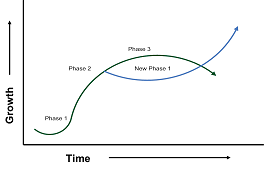ATD Blog
Growing Talent Development Firms: Grow or Die?
Thu Mar 16 2017


Figure 1: The Growth Curve
At this point, assuming you make it through this first phase successfully, the rules change. They now require you to replicate, or create normative patterns responsible for what you have done to be successful. If you are successful in phase two, you will continue on a path of continued growth limited only by the resources you have available to support it. But eventually these resources for success get consumed or become irrelevant for continued success as market conditions change or get more demanding. Sometimes, this is caused by the “fat and happy” syndrome. Why change when everything else is going well? But to progress, keep pace, and jump over any resource barriers, something has to break.
This is where innovation or reinvention and integration enter the picture and where some significant change must take place to avoid a fourth phase, decline. Ainsworth-Land calls this a bifurcation, or division of something into two branches or parts. At the top of the S-curve, you either move forward through a plateau characterized by stagnant performance, or reinvent your business and start phase one again, repeating the transition to phase two, eventually bifurcating again before ever getting to true decline. And, a new S-curve is born.
Supporting Ainsworth-Land’s theory is research conducted showing the average lifespan of U.S. public companies, defined by how long it takes to delist them. In 1970, the average lifespan of a company was 55 years. Just 40 years later, in 2010, it had decreased to 31.6 years. The main reason offered for this change is a company’s failure to adapt to increasing complexity. Just like biological species, companies are complex adaptive systems that must continually evolve, often in somewhat unpredictable ways, resulting in even further changes to the system. With all the various disruption taking place today, and likely in the future, it should not be surprising to see the average company lifespan continuing to decrease as companies are unable to adapt to change.
The conclusion you might draw from Ainsworth-Land’s theory as it applies to your business in the talent development industry is growth not only is required for long term success, but also must be considered realistic. Growth can also be painful in many ways if not managed effectively. While growth appears to be most desirable given the alternative, there is always the chance that highly accelerated and successful growth can come with downsides. That is, you can be so successful so fast you haven’t adequately prepared your business to deal with its growth pace.
The irony of success potentially breeding failure, or the success-disaster paradigm, makes building and sustaining a business a long and hard process, not for the faint of heart. You might think this would be one of those problems you’d like to address, but it could be a problem if you don’t have the bandwidth or tools to manage. The result is as fast a fall from the top of the hill as the rise to it. The lesson is that growth needs to be managed and planned just as you might lay out your strategy for the next year. Not doing so will likely result in the failure of success. For an interesting perspective on the failure of success, see Ainsworth-Land’s 2013 TED Talk.
My new book is all about growth, whether you choose to become or remain a one-person consulting practice, or build a several-hundred-person, multimillion-dollar business. Growth requires taking some risks, getting uncomfortable, and charting new territory. The journey can be fraught with surprise and unexpected events, but it also can be celebrated by these very same events. The good news is by keeping your eyes wide open and consciously making choices with which you are most comfortable, you will be able to successfully manage and even overcome any signs of pain.
To learn more, check out my book page. Also, join me at ATD 2017 International Conference & Exposition for my session: How to Build and Grow a Successful Talent Development Business.
**As ATD prepares to publish my new book, The Complete Guide to Building and Growing a Talent Development Firm, I thought a good final blog post, at least for now, should focus on the alternative to growth. That is, what if you don’t want to grow your business? Are there reasonable alternatives to growth? The following is an excerpt of how I responded to this question in the book.

Unfortunately, the dire outcome to not growing is dying, originally proposed by George Ainsworth-Land in his 1973 Pulitzer Prize–nominated book, Grow or Die. In it, he posed the “theory of transformation,” which has become a cornerstone in the strategic planning and organizational transformation efforts of companies throughout the world. The theory is that growth is the most basic and universal of all drives, whether biological, psychological, chemical, physical, or cultural.
Ainsworth-Land suggests applying this theory to the growth of organizations which, like nature, grow through a process of de- and reconstruction of all their components in a pattern of formation, self-imitation, success, and renewal. If renewal doesn’t take place, the organization simply dies. It is at this point he addresses how change occurs as a series of interlocking sigmoid curves (S-curves), each with two or three points at which the rules of survival change if the entity is to continue growing.
The phases, depicted in Figure 1 (see below), are formative, normative, and integrative. Phase one, formative, is characterized by experimentation, during which the organization attempts to find a connection with its environment. Think how you might be trying to determine if there is a connection between your offer and the marketplace. Some organizations can die at this point before finding this connection. Think about some startups that never make it to market.
**
